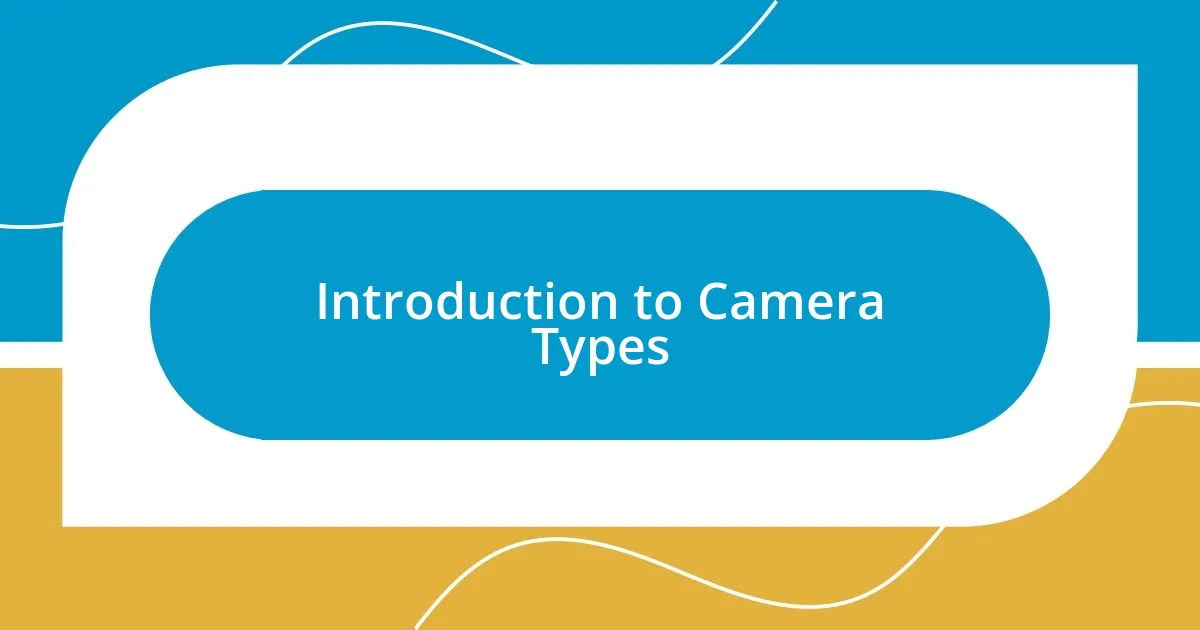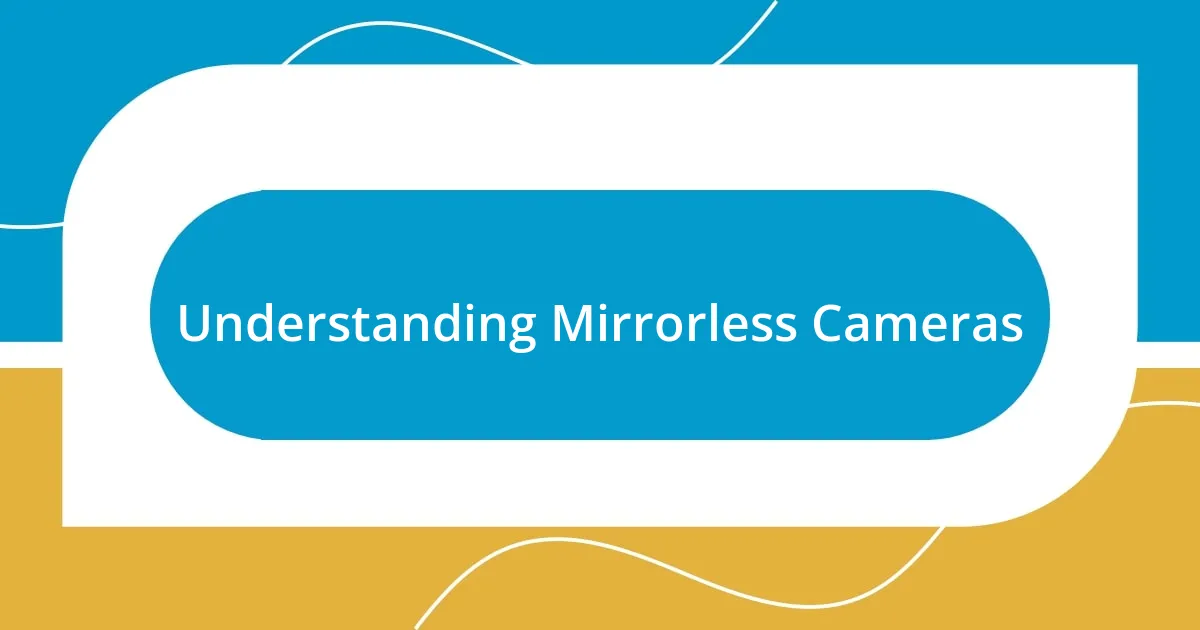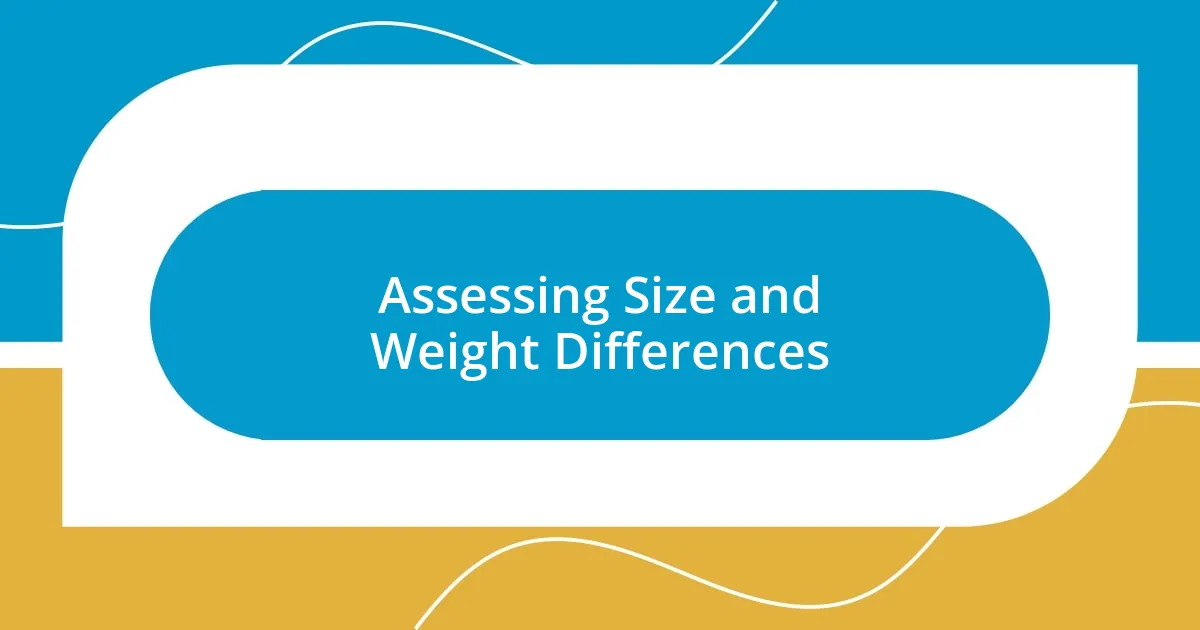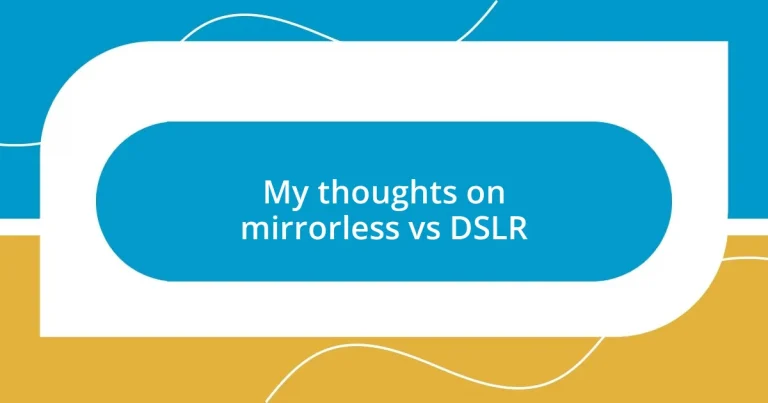Key takeaways:
- Mirrorless cameras offer a lightweight design and advanced technology, including faster autofocus and the ability to use various lenses through adapters.
- DSLRs are favored for their optical viewfinders, robust build quality, and superior battery life, giving users a tactile and immersive shooting experience.
- Image quality can vary based on personal preference, with mirrorless cameras excelling in low-light situations and DSLRs providing rich colors and a direct connection to the scene.
- Autofocus performance differs significantly, with mirrorless cameras featuring advanced eye-tracking capabilities, while DSLRs excel in fast-moving scenarios.

Introduction to Camera Types
When it comes to photography, choosing the right camera type can feel like stepping into a maze. I remember my first experience with a DSLR—it was bulky yet exciting, with a satisfying click that made me feel like a professional right away. The weight of the camera in my hands was a physical reminder of the creative journey I was embarking on.
On the other hand, I couldn’t help but feel a thrill when I picked up my first mirrorless camera. It was a game changer: lighter, quieter, and packed with innovative technology. How often do we find ourselves balancing the nostalgia of traditional photography with the allure of modern advancements? It’s a constant tug-of-war I still navigate between fondness for my old gear and the efficiency of newer options.
Both DSLRs and mirrorless cameras have their unique charm and functionality. I’ve often found myself wondering—not just about the technical specs—but what style truly resonates with my creative spirit. Each camera type opens up a different world of possibilities for expression, and discovering which one speaks to you can be a deeply personal journey.

Understanding Mirrorless Cameras
Mirrorless cameras have truly transformed the photography landscape. When I first started exploring them, I was struck by their compact design and advanced features. One aspect I remember vividly was the electronic viewfinder, which allowed me to see exposure effects in real-time—something I greatly appreciated as it made adjusting settings much more intuitive.
What really excited me about mirrorless systems was their autofocus technology. I often found that tracking moving subjects became easier, making it perfect for capturing candid moments at family gatherings. The lightweight body also made spontaneous photography a breeze, since I could just slip it into my bag without feeling like I had an extra workout.
One thing I’ve learned while using mirrorless cameras is their adaptability. Many models now support lens adapters, allowing you to use various DSLR lenses, which can be a real bonus. I still remember the first time I mounted a vintage lens—I felt like I was holding a piece of history in my hands, merging the past with modern technology. This versatility is what makes mirrorless systems an exciting choice, whether you’re a hobbyist or a professional.
| Feature | Mirrorless Cameras |
|---|---|
| Weight | Lighter than DSLRs |
| Viewfinder Type | Electronic viewfinder or LCD screen |
| Autofocus | Faster, often more accurate for moving subjects |
| Lens Adaptability | Can use adapters for DSLR lenses |

Exploring DSLR Technology
DSLR technology has a rich history that many photography enthusiasts hold dear. I recall my first time adjusting settings on a DSLR; it felt like I was taking a step into a larger world of creativity. The tactile sensation of turning dials, along with the reassuring weight of the camera in my hands, made me feel fully immersed in the art. The optical viewfinder, a standout feature of DSLRs, provided a clear image of what I was capturing, which I found both comforting and exhilarating.
When I think about the core components that make DSLRs special, a few key elements come to mind:
- Optical Viewfinder: Offers a direct view through the lens, giving a real-time view of the scene.
- Interchangeable Lenses: Allows for a wide variety of lenses tailored to different photographic styles.
- Robust Build: Many DSLRs are designed with durable materials, making them reliable in challenging shooting conditions.
- Battery Life: Typically superior to mirrorless systems, allowing for extended shooting sessions without frequent recharging.
- Familiar Control Layout: For many seasoned photographers, the ergonomics and controls feel intuitive and easy to navigate.
Each of these aspects not only defines the technical capabilities of DSLRs but also shapes the experience of using them. Every click of the shutter feels deliberate, almost like a conversation with the moment I’ve captured, and I cherish these technical nuances that enhance my creative journey.

Comparing Image Quality
When it comes to image quality, both mirrorless cameras and DSLRs have their strengths. I recall a weekend trip where I set up my mirrorless camera under the stars, amazed by how well it captured the night sky’s vibrancy. The noise performance at high ISO settings was surprisingly good, showing me that mirrorless systems can compete fiercely in low-light conditions, which I never anticipated.
On the flip side, I also remember the crisp, rich colors I captured with my DSLR during a golden hour shoot at the beach. There’s something about the optical viewfinder that flat-out engages me—providing a direct connection to the scene without any electronic interference. I’ve often wondered if that tactile experience adds something to the final image, making it not just a photograph, but a moment I physically felt.
Ultimately, the choice between these systems can hinge on personal preference as much as on raw image quality. Have you ever noticed how different lenses can dramatically alter the character of your shots? I still find myself leaning towards my favorite prime lens on my DSLR for portrait work; it delivers a stunning bokeh that truly makes my subjects pop.

Evaluating Autofocus Performance
When I switched to a mirrorless camera, I was blown away by its autofocus capabilities. I remember a family event where I captured moments of my nephew running around. The eye autofocus feature tracked his every move with incredible speed and precision. It felt almost magical, as if the camera was predicting his next steps. Have you tried using eye-tracking autofocus? If you haven’t, I highly recommend giving it a go; it can really enhance your portrait shots.
By contrast, my experience with DSLR autofocus has been a bit different. I fondly recall shooting sports events, where the phase-detection autofocus excelled at locking onto fast-moving subjects. It gave me that satisfying reassurance, knowing I could capture the perfect moment without missing a beat. The rapid-fire shots I took of athletes leaping through the air stand out in my memory. You can’t underestimate the power of a solid autofocus system, especially when you’re in the heat of the action.
In terms of versatility, I’ve seen both systems shine in different environments. For instance, while traveling through a bustling market, my mirrorless camera’s silent shooting mode allowed me to capture candid street portraits without intruding. That felt fulfilling. On the other hand, DSLRs tend to perform reliably in low-light situations, where I’ve gotten some of my favorite candid shots during evening events. The performance of autofocus can truly shape a photographer’s experience, and I find it fascinating how personal preference plays such a significant role in choosing between these systems.

Assessing Size and Weight Differences
When I first picked up a mirrorless camera, one of the first things that struck me was its lightness. I remember hiking up a scenic trail with nothing but my mirrorless setup slung over my shoulder. The weight difference compared to my old DSLR was remarkable, making it far easier to lug around for hours. It begs the question—how much does portability influence your shooting experience? For me, the answer lies in being able to shoot longer without feeling fatigued.
In contrast, I’ve often found that my DSLR feels more substantial in hand, which can actually enhance stability during critical shots. I recall a vibrant wedding where I was able to gracefully pivot and reposition my camera, leveraging that heft to steady myself during a flurry of activity. The density of the DSLR makes me feel more connected to the process of taking photos, almost like a reassuring weight guiding my creative decisions.
Still, size isn’t everything; I’ve discovered the versatility of compact mirrorless lenses, which can fit snugly in my bag. Have you ever considered how different lenses contribute to the overall experience? I think about my time exploring cityscapes, where I would trade a heavier lens for the convenience of something that takes up minimal space. It’s these small yet impactful choices that shape our adventures as photographers.














